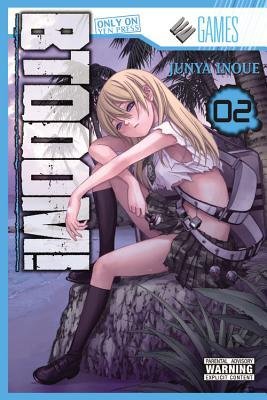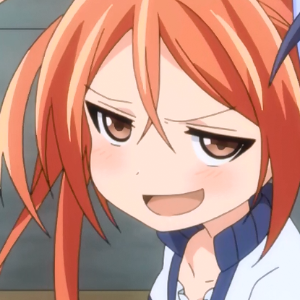Michael's Long Box - BTOOOM! by Junya Inoue (2013, Yen Press)

Note: This review covers the entire BTOOM! series, not only this volume. There are no spoilers.
My first impression upon reading BTOOM!'s description was, "Oh goodie! Another Hunger Games/Battle Royale rip-off. Just what the world needed." You can't really blame me though. The set-up's identical: a bunch of people, selected for reasons unknown to them, wake up on an island where they kill one another off until a winner emerges, while an audience watches the action on live-stream. Along the way, alliances are formed, friendships destroyed, and paranoia creeps in as the survivor count dwindles, the days turn into weeks, and supplies run low.
Where have I seen such a scenario before, I wonder...?
But BTOOM! manages to overcome this "me too" syndrome and emerge as its own stand-alone story set in the modern world, where ranked online gaming is basically a championship sport, and an entire generation of societal "drop-outs" (known as 'Neets', they're people who have decided to pour their energy into online interactions instead of in-person social activity) is changing Japan's cultural and social landscape in real-time.
BTOOM! is actually two games in one. The first BTOOM!, and the one everybody knows about, is a massively-multiplayer online combat game set in a futuristic world where players adopt virtual avatars and deathmatch using devices called 'Bim'. Imagine Call of Duty or Halo, but where your main weapons are explosives with different types and usages. Some are contact explosives, some have homing properties, some are defensive in nature and create a shield around the user, some throw out swarms of smaller explosives, some can be placed like landmines, and so forth--there's an endless amount of strategy that goes into learning how to use Bim effectively, and the top-tier players of the game have honed this skill to a razor's edge.
This is where our protagonist, Ryota Sakamoto, shines. As one of the ten highest-ranked BTOOM! players in the world, the 22-year old Ryota is a self-professed Neet who has turned his back on everyone (his job, classmates, step-dad, even his own mother) to maintain his skills and reputation as one of the best-of-the-best in this online world. He's even met Himiko, a highly-ranked and regarded female player who admires his skill, and the two have a puppy love cyber-relationship, even though they've never so much as talked in real life. As far as Ryota's concerned, this was the life he was always meant to live. The digital world of BTOOOM!'s a place where people all over the globe fear and revere him for his prowess; how the hell could real life possibly compete with that?
Well...
As far as someone else is concerned, this makes Ryota an ideal candidate for the other BTOOM!, the live-action, holy-shit-this-is-for-real game described in the first paragraph. Ryota's memories are hazy: last thing he remembered was playing BTOOM! on his Xbox 360, but now he's awake, dangling several feet up in the air from a parachute tangled in a tree, with a chip implanted in his hand and a container filled with real-life Bim. As the explosions start going off and he tries to get his bearings, Ryota comes to the inescapable conclusion that not only is he playing BTOOM! for real, but everybody else on the island is as well.
BTOOM! is a solid, fast-paced action extravaganza with just enough to set it apart from other dystopian literature based around a similar premise. Like the best dystopian fiction, it uses an outlandish premise to reflect and offer commentary on current cultural, social, and political trends. "If you don't like what you see," mangaka Inoue tells us, "start working to change things before it's too late."
The manga offers nicely-detailed back-story on all the participants, which unfold in flashback sequences explaining exactly who they are and what circumstances led to their inclusion in the game, and holds its story together very well over multiple volumes. Everything that happens has an explanation, though you may not get it immediately. This is obvious from the first book, where Ryota stumbles across a series of bodies, including one in the process of being consumed by insects, and another guy naked from the waist down, floating in a lagoon. We eventually meet these people and learn how and why they met their fates, but only several chapters later. When Inoue shows us explosions off in the distance, or a quick flash of a combatant to whom we've not yet been introduced, you can trust everything will eventually be explained. There isn't a throwaway scene in the whole series.
BTOOOM! contains a minimal amount of fan service and light nudity in a few chapters, but it's not anything over-the-top or even unrealistic, despite what the cheesecake-y covers lead one to believe. Even the violence is more subdued than one might expect of a title where people blow one another to pieces with miniature bombs. It's not a story for kids, but it's far less brutal than, say, the manga adaptation of Battle Royale which, though awesome, relished its images of spilled intestines, gun-shot faces, and severed limbs a little too heartily in my opinion.
Highly recommended for anyone who enjoys social commentary with their dystopian future manga, BTOOM! is a solid read from start to finish. Just when you think you know what's coming, Inoue hurls a wrench into the works and jerks you in a direction you couldn't have anticipated. What's more, when the end is in sight and our heroes prepare to win the day, he throws the curve ball of all curve balls, splitting the main characters up and dropping them into even worse scenarios as the designers of the real-life BTOOM! patch the 'bugs' in their system and ramp up the mayhem to satisfy an insatiably blood-thirsty audience, both in the manga and in real life.
Funny - you drop a couple of terms I've recently learned. NEET (which stands for Not in Education, Employment, or Training, and rather uncomfortably describes my current situation...) and "Fan Service," which (if I understand correctly) is the use of pornographic images to titillate manga readers.
I have a female friend who has built a personal library of 1000+ manga volumes. I asked her if she found the hyper-sexualization of women (and especially young women) as creepy as I did, and she said, "Nah, that's just fan service." Which left me feeling that I was just being an old prude. But...some of those covers, man...
With a story as violent as this one, though, who's to complain about a little extra titillation?
Hiya, @winstonalden! Ryota self-identifies as a "neet" early on in the series, and this was my introduction to the word. I wasn't sure if Inoue invented it or not (a quick internet search says it originated in the UK, so I guess not). It's a useful term, though I'm sorry to hear you find yourself fitting the definition at the moment.
"Fan service" has been around for ages though. It specifically refers to sexually-charged imagery inserted into anime or manga in a gratuitous fashion. The idea is the artist or animator didn't have to draw the scene at an angle where it was possible to see the girl's underwear (for instance), they just did it anyway because the fans would enjoy that sort of thing.
If the manga/anime is primarily erotic or sexual in nature, that's not really "fan service". If there's no reason for a bunch of girls to suddenly decide to take a bath together or otherwise ditch practical clothing for less-practical outfits, on the other hand... :)
I'm actually pretty happy with my neet status at the moment. I consider myself one of the "gratefully unemployed," and intend to keep it that way for as long as possible. (From a traditional viewpoint, though, I may look a bit of a layabout.)
The whole Manga thing is a bit bewildering to me, I must admit. Haven't really given it a fair shot, though, so it's not something I can criticize intelligently. I appreciate you sharing your take on this series.
Hey, if you're happy with the hat, go ahead and wear it! We all can use a break, and if you've got the means to take one, I'm not going to fault you. :)
Manga's weird like that. I discovered it in the late 80's, and found it interesting due to it telling stories in comic form that were utterly unlike traditional Marvel and DC books of the day. Mai the Psychic Girl, for instance, had no analog in the world of caped crusaders and strange visitors from another world, and that was part of its charm. The downside was a much smaller distribution and lack of availability, and I spent years filling in back-issue holes that today would take me five minutes on eBay. The hunt was part of the fun though. :)
Nowadays, manga's far more mainstream. Mainstream bookstores have racks and racks of it, and somebody trying to get into it could easily get overwhelmed at not just the number of titles, but the number of volumes associated with each title. You've got popular series like Bleach, One Piece and Dragon Ball Z up into the high-double or even triple digits' worth of books to collect if you want the whole story, and that's a significant outlay of money. I personally tend to avoid the long-running or endless series like them, because I have neither the time nor the cash, so my focus is more towards self-contained series that run 12 volumes of less. That's not to say I won't approach longer content (Gantz, for instance, ran for over 380 chapters and I devoured every last one of them), but they have to be something special. Stuff in my Longbox column is meant to focus on more approachable series, so while I'm not about to cover all of Superman or Batman, one-shots or trade paperback compilations aren't off the table. I hope you enjoy what's yet to come!
Interesting to see the term "fan service" used by you and the other poster as something sexual, which if that is the origin that is funny, I just think the term has expanded to mean more. Like I would consider a lot of Kevin Smith material "fan service" in the sense that material that a general audience wouldn't get or understand unless you were a longer term fan and know "in jokes" and stuff.
Hi, @cryplectibles! I use the term in that sense only because it originated in the anime/manga community to describe that activity. It's since broadened here in the West to mean pretty much "anything a creator does to add value specifically pleasing to the core audience" (a classic example would be C-3PO and R2-D2 in the hieroglyph carvings on the Ark of the Covenant in Raiders of the Lost Ark), and you're absolutely right. :)
Smugvoted.

Congratulations @modernzorker! You have completed some achievement on Steemit and have been rewarded with new badge(s) :
Click on any badge to view your own Board of Honor on SteemitBoard.
For more information about SteemitBoard, click here
If you no longer want to receive notifications, reply to this comment with the word
STOPSounds interesting! A lot like the Hunger Games like you said, but refined and put through the lens of Japanese culture. I'm glad to hear, also, that there's minimal fanservice. I may have to check out the manga sometime, see if the library has it or if I could put a hold on it.
It's also recieved an anime adaptation, which I would solidly rate as "kind of okayish".
I was wondering about this. I knew it got turned into an anime, but little else. Good to know I don't need to go out of my way to track it down. :)
It's on Crunchyroll, if anyone's curious. I'd recommend Sword Art Online over Btooom.